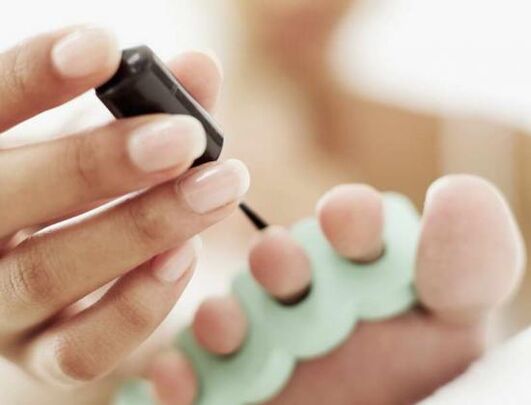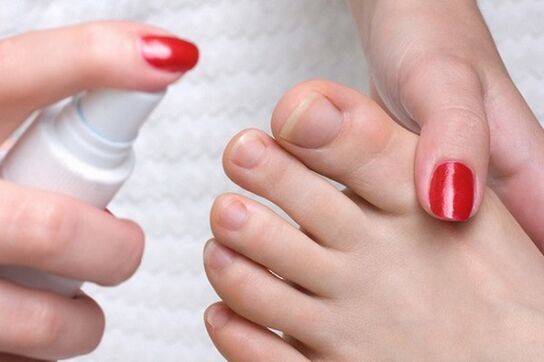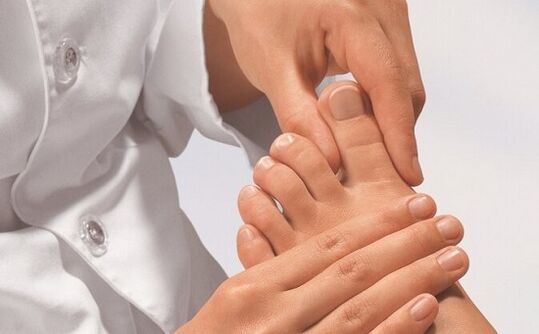
Nail fungus (lat. Onychomycosis)-in other words-a fungal infection of the nail. This disease affects the nails of the hands and feet. The main reason is the so-called dermatophytes, and less common are fungi of the genus Candida (yeast) or mold.
Color changes, thickening and brittle nails are symptoms of fungi, as well as other diseases of the skin and nails. Therefore, if such changes are found, it is necessary to contact a dermatologist and conduct a bacteriological examination for the presence of fungus, and as a seed.
It is estimated that about 50% of people with rough and discolored nail plates on the palms and feet suffer from nail fungus.
Causes and symptoms of nail fungus
Nail fungus usually appears after infection with foot fungus. According to research, up to 42% of people have foot fungus, and 21% have nail fungus. Men suffer from it more often (except for candidiasis), rarely children, but usually the elderly. This disease affects all races equally.
In most cases, in temperate climates, fungal nail infections are caused by dermatophytes, namely Trichophyton rubrum (70% of nail fungus cases), Trichophyton mentagrophytes (20% of all nail fungus cases), Trichophyton interdigita, Epidermophyton flocculus, Trichophytontonshophyton violaceum, Microsporum gypseum soudanense and Trichophyton verrucosum. In the world, in addition to dermatophytes and yeasts, there are more and more cases of fungal infections of other species, namely Fusarium, Mycobacterium brevis, and Aspergillus. In some countries, Aspergillus. It is the cause of up to 15% of fungal cases.
You may be infected with fungi, such as:
- In the swimming pool,
- In the sauna,
- Put on someone else’s shoes or put on someone else’s socks,
- By using someone else’s manicure equipment.
- Fungus often appears between the toes.
What is nail fungus?
If the nails are damaged, the fungus that has appeared on the skin of the feet can penetrate the skin and nails. It may be that the cut or nail is cut too short. Nail diseases often affect fragile nails, especially the use of nail polish and false nails can lead to fragility.
In addition, some patients are susceptible to this type of infection due to various diseases. One of them is immunosuppressive diseases (immunosuppressive states), such as long-term treatment with immunosuppressive drugs after HIV infection or organ transplantation, or certain autoimmune diseases.
Another group of problems related to the increased risk of nail fungus is hormonal imbalance (disease or Cushing’s syndrome, hypothyroidism, etc. ). This disease is more common in the presence of metabolic diseases, such as diabetes, which is a disease that causes various infections, not just fungal infections.
The fungus is more common in obese people with anemia (anemia), circulatory diseases that cause nail plate ischemia, and gastrointestinal diseases.
Nail fungus often affects patients with malignant tumors who receive antibiotic treatment (especially those who are not taking probiotics at the same time), and patients who take steroid drugs known to have immunosuppressive effects for various reasons, that is, patients who destroy their functions. immune system.
No matter which part of the nail is affected, there are four main types of nail fungus. The most common type of fungus affects the distal (distal) part of the nail, including the upper nail plate, which is the skin below the nail plate.
Symptoms of nail fungus

Interestingly, nail fungus may be asymptomatic at first; in these cases, it will only increase the fragility and slight discoloration of the nail plate. Only after a period of time does the characteristic and significant changes in the appearance of the nails begin to appear.
The symptoms of onychomycosis, first of all, changes in nails, especially in the early stages of disease development. The first change usually appears on the free edge (front) or side of the nail plate.
With the further development of nail fungus, other problems may arise during physical activities (such as sports) and even walking and standing. Then the patient complained of paresthesias (numbness), pain, discomfort, and decreased physical fitness. The characteristic changes in the nail during the fungal process include:
- Color changes-nails become white, yellow, brown, green,
- The nail plate peels off and peels off, significantly increasing the brittleness,
- The ripples of the nail plate,
- Thickening of the nail plate, which is a symptom of hyperkeratosis,
- Unpleasant foot smell.
Fungi can have various symptoms. Two different patients infected with the same type of fungus may experience different changes in nails.
Toenail fungus may have some unique characteristics. It can be called by so-called. Mold. This form of fungus is often found in elderly people and is related to impaired blood supply to nails (nutritional disease). The nail plate of the thumb became thick and deformed, showing a yellow-green color, and a significant thickening of the epidermis was observed under the plate. Usually, nail fungus will persist for many years without treatment. Unfortunately, even after proper and long-term treatment, this disease can recur.
The above symptoms are usually determined by fungi. In addition to the characteristic appearance of nails, detecting skin fungi on the feet and hands that often accompany nail fungal infections can help diagnose nail fungus. However, the diagnosis is not always obvious.
In some cases, additional laboratory analysis is required. The doctor takes a sample and examines it under a microscope. Another auxiliary analysis for the diagnosis of onychomycosis is the culture of the fungus taken. Therefore, it is possible to determine their types and check the sensitivity to specific drugs.
If the doctor suspects that a given patient has nail fungus, he or she should also consider other conditions that may have similar conditions, namely:
- Nail psoriasis-it may look similar, but the characteristic difference of this disease is that it often affects all nails symmetrically; in addition, psoriasis is usually accompanied by typical skin changes;
- Nail thrush (or candidiasis) is another nail fungus, which is different from the classic fungus and is related to dermatophyte infection; it is characterized by purulent discharge from under the nail ridge and soreness;
- Nutritional changes caused by disrupting the blood supply of the nail plate; usually starting from the proximal end of the bone plate (ie at its bottom);
- Lichen planus is a disease in which the appearance of papules (changes) on the skin and mucous membranes is characteristic, and the presence of lichens can usually be easily distinguished from fungi; the nail plate with lichens has characteristic longitudinal waves.
When pressed, purulent contents will appear. If the change of Candida does not disappear for a long time, the nail plate will become grayish-yellow-brown, lose luster, rough and fall off.
Candidiasis of the nail plate and roller must be distinguished from panaritium, which is a bacterial infection. First of all, it is different in that it is limited to one finger and progresses more intensely and pains more. In addition, candidiasis may be confused with "common" nail fungus and nail psoriasis.
For the final diagnosis of thrush, it is necessary to culture (candida culture). It is impossible to identify the fungi of this family in direct preparation, that is, by examining the secretions taken from the painful area without culture.
To conclude the discussion on the symptoms of nail fungus, it is worth reviewing the psychological problems that patients with this disease may encounter. These include a decline in self-esteem and deterioration in social contact. These problems are especially relevant to those who are infected with nail fungus.
Ways to treat nail fungus

Treatment of nail fungus is a must. Lack of treatment for nail fungus can lead to a chronic and progressive course of the disease. There can be no natural recovery. Therefore, it is always necessary to make an appointment with a dermatologist in the case of suspicious changes in the palm or nail area.
Even if it turns out that the cause of this disease is not a fungal infection, only a dermatologist can determine which disease a patient has.
Unfortunately, the treatment of the disease in question is difficult and not always effective. This is because depressed patients simply stop using prescription drugs. For the treatment process to be effective, its duration should be several months, even after the symptoms disappear.
In the initial stage of the fungus, when the changes on the nails are still not noticeable, a fungicidal ointment is sufficient. When the fungus starts, oral medications are usually used. The fungus recurs very frequently, so you should follow the advice of a dermatologist and pay attention to foot hygiene after recovery. Many patients refuse treatment immediately after the symptoms disappear. This is wrong because it may cause relapse and require treatment to be started again.
Home treatments for nail fungus are usually ineffective.
Changes in nails should be checked by a dermatologist. What you can do to promote treatment is to maintain foot hygiene, wash and dry your feet thoroughly, don't cut your nails too short, and don't use other people's nail equipment, towels, socks, and shoes.
Generally speaking, the treatment of nail fungus depends on the type of infection, the clinical type of disease, the number of infected nails, and the degree of damage to the plate. In some cases, systemic treatment with oral medication is required. Sometimes local treatments are sufficient, namely ointments, creams. There is no doubt that the combination of systemic treatment and local treatment has improved the success rate of onychomycosis treatment. Unfortunately, even with the latest drugs, the recurrence rate of nail fungus is still high. In the future, photodynamic therapy and laser therapy may be used in the treatment of this disease.
Effective medicine for nail fungus
Local therapy without oral drugs should be used only when the lesions occupy less than half of the distal (distal) part of the nail plate, and when the patient cannot tolerate systemic treatment well. These are rare cases-usually, unfortunately, topical treatments are not enough.
Generally, topical treatments used as the sole treatment for nail fungus cannot completely cure it because they cannot penetrate deep into the plate.
Indeed, it is thought that the solution will penetrate all layers of the nail, but if used as a monotherapy (as the only medicine), they are still ineffective. However, these drugs can be used as "adjuvant" therapies, adjuvant treatments with oral drugs, or to prevent recurrence in patients who have previously been treated with systemic (oral) drugs for onychomycosis.
Medications for nail fungus
Oral treatment of nail fungus cases is almost always necessary. The latest generation of oral antifungal drugs have recently replaced older generation drugs in the treatment of nail fungus. The effectiveness of the new agents lies in their ability to penetrate deeply into the nail plate within a few days after the start of treatment.
By using them, the duration of treatment can be reduced while achieving a greater percentage of recovery and fewer side effects.
In the case of treatment through these methods, patients should arm themselves patiently and calmly wait for healthy nails to grow after the treatment is over. This may take more time.
Remove nail fungus
Removal of nails affected by fungus is also considered a solution. For nail fungus, surgery can be used. Here, we are talking about mechanical or chemical removal of infected nail plates. The plates can be chemically removed using 40-50% urea solution. This is a painless method and is effective when the nails are thick.
For patients undergoing oral therapy, removal of the nail plate should be considered as an adjuvant therapy. The combination of oral, local treatment (lubrication) and surgery has a higher cure rate and is also the most effective and cheapest option (least recurrence, short-term treatment).
During the treatment of onychomycosis, there is no need to restrict general activities, but it is recommended to avoid places where contamination may occur, such as public swimming pools.















